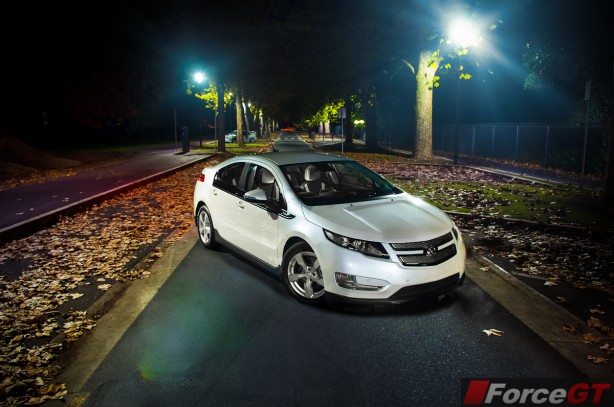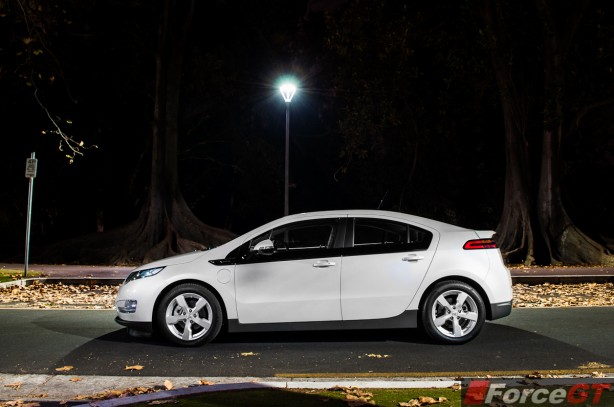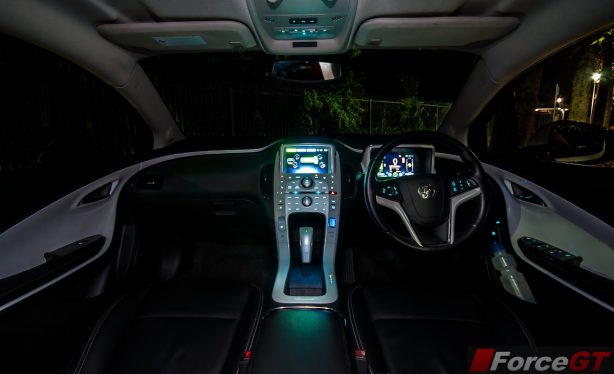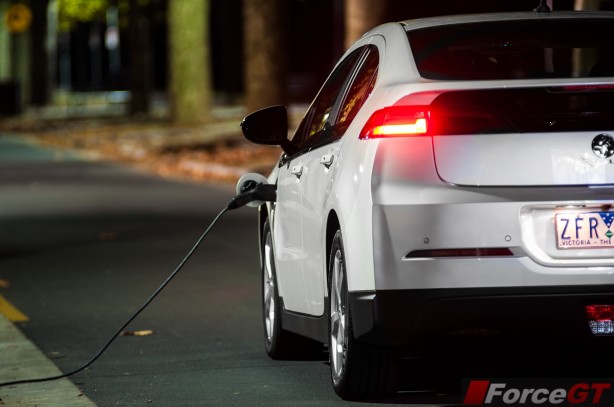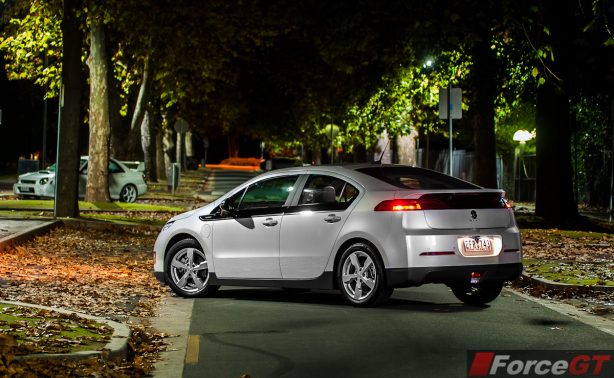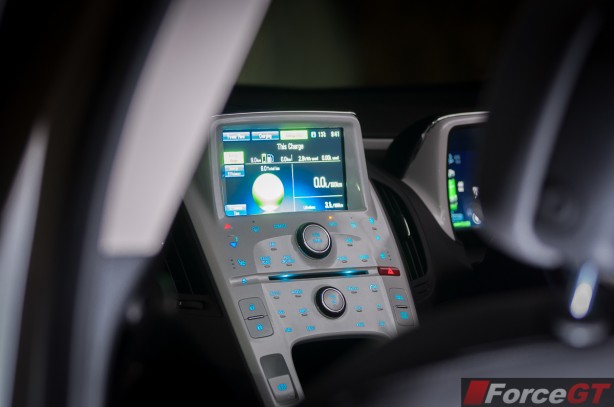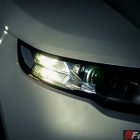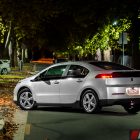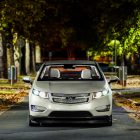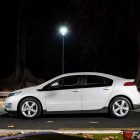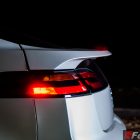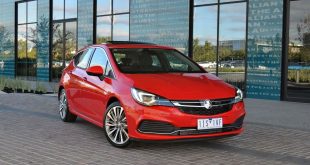Electric cars aren’t new. In fact, the first electric vehicle was created around 1890, when an American with the name of William Morrison installed an electric motor into a six-passenger wagon. It had a top speed of 23km/h. But with cheap oil in abundance, the electric vehicle didn’t get much attention, until now.
Up until recently, the poster child of green mobility has been the Toyota Prius, the world’s first mainstream petrol-electric hybrid car. I won’t bore you with the intricacies of its workings as I’m sure you would be relatively familiar with it by now – its petrol engine and electric motor work in parallel to reduce fuel consumption to levels polar bears would roll around with joy in.
However, it still isn’t fully emission free, with an electric only range of just 1-2km and a top speed of up to 50km/h before the engine takes over. That pretty much means short runs to the shops only.
Cue the Holden Volt, an ‘extended range electric vehicle’ (General Motors insists it isn’t hybrid), that is capable of up to 87km of zero emission motoring. It is a one-of-a-kind, all-electrically driven vehicle based on GM’s Delta platform, which also underpins the Holden Cruze and Opel Astra.
Unlike full electric vehicles, you don’t get range anxiety in the Volt as it carries a backup generator in the form of a 1.4-litre petrol engine to charge its batteries and ensures there’s always drive to the front-wheels.
“What is it like to drive?” I hear you ask, let’s find out….
Design & Comfort
Unlike other cars, the Volt’s design is dictated very much by aerodynamics. Its distinctive wedge shape is the result of hours spent in the wind tunnel. With a drag coefficient of just 0.28, it slices through air like a well-honed samurai sword, and contributes an estimated 5km of electric range and 80km of extended range.
Its rounded and flush front fascia, tapered corners and grille, carefully designed integrated rear spoiler and an aggressively raked windscreen and back glass all work together to reduce turbulence and drag.
It’s a different story inside. Designers are given a free rein with their crayons and the result is an unmistakably futuristic cabin. The instruments have been replaced with a high-resolution 7” colour LCD display with configurable Driver Information Centre, while the gloss white centre stack are filled with touch-sensitive buttons that glow a soft blue at night. Another high-resolution 7” LCD touch screen is perched on top for infotainment and climate control.
The Volt is a strict four-seater, as the battery intrudes in the shape of a large centre tunnel. Its cabin is light and airy with good visibility, except for the chunky A-pillars that will put the columns on the Pantheon to shame. Rear seat passengers should also ideally be no taller than a Hobbit, due to the sloping roofline.
Lifting the rear hatch reveals 300.2 litres of cargo space, 112.8 litres down on its Cruze Hatch sibling. It is, however, expandable by folding down the rear seats.
Score: 8.0/10
Performance and Handling
Tipping the scales at 1,721kg – 198kg of which comes from the battery system, the Volt isn’t the most nimble hatchback in town, although this is well disguised by its 111kW electric drive system.
Unlike a conventional hybrid, the Volt is driven by a pair of electric motors at all times, with its extended driving range provided by a 63kW 1.4-litre petrol engine. During electric-only phase, the battery, motor and power electronics are designed to deliver full performance in acceleration, top speed and hill climbing.
Significantly, the Volt drives not unlike a normal hatchback, with the added bonus of being super quiet. The ‘engine’ fires up with hardly a murmur when you press the pulsating start button. Pull the gear lever into Drive and you glide away silently.
The motor delivers power linearly and smoothly, helped by the fact that there are no gear changes to interrupt the process. There is also a Drive Mode button that allows the driver to choose between Normal, Sport and Hold, with the default being Normal. Sport mode sharpens throttle response and dials in torque earlier, much like turning up the turbo boost on a combustion engine with noticeable effect.
Meanwhile, Hold allows the driver to engage the petrol generator as the power source, even when the battery is full.
While the transition between battery and generator is barely noticeable, its presence is felt through slight, but inevitable, quiver in the steering wheel and pedals. More notable is the disconnect between the rush of torque and the surge in engine noise, as you would expect from a normal car.
In the Volt, the engine noise is delayed by a few seconds, as it revs up to release more electrons from the battery. Otherwise, its steering is well weighted and there is none of the dramatic pedal feel from the regenerative braking system you get from similar systems on other cars.
Throw it into the bends and the 215/55 low rolling resistance tyres will scramble for traction, especially in the wet, with understeer rearing its ugly head earlier than other cars. However, back off on the throttle and the car will easily track back into its line.
Score: 7.0/10
Quality
The American-built (manufactured at GM’s Hamtramck Assembly Plant in Detroit, Michigan) Holden Volt is surprisingly well made, with consistent fit and finish. There is also a noticeable absence in squeaks and rattles on our 9,000km test car.
For extra peace of mind, the Volt is offered with an eight year/160,000km transferrable warranty that covers the battery and Voltec electric drivetrain components. This is supported by a three year/100,000km warranty on the vehicle.
Score: 8.0/10
Economy
According to Holden, the Volt has a pure electric range of up to 87km, depending on driving conditions. Together with a full tank of fuel, it is capable of covering over 600km.
In the real world, the batteries consistently returned 68km on full charge, giving the Volt a not unreasonable 581km range.
Like most electric or hybrid vehicles, it makes most sense when used in an urban environment, where most city dwellers commute fewer than 80km daily.
Based on current tariffs, the Volt can be fully charged from empty for as little as $2.50.
Score: 9.0/10
Features
The Volt offers comfort, convenience and safety features expected of a premium vehicle.
Key features include touch-control switch system on the centre console, customisable charge modes, Bluetooth with voice recognition, satellite navigation system with 30GB hard drive and DVD player, Premium Bose audio system, keyless entry with proximity key, parking sensors front and rear, reversing camera and LED daytime running lights.
There’s also Lane Departure Warning, Forward Collision Alert and eight airbags, including front knee airbags.
Score: 8.5/10
Verdict
The Holden Volt is the motoring future, adapted for our time. It provides guilt free mobility while eliminating range anxiety usually associated with electric vehicles, making it viable for the masses. It also drives and operates just like a normal car.
However, for its $59,990 asking price, you’ll want to weigh up its return on investment compared to a normal hybrid or diesel powered cars.
| Price (Excl. on-roads): | From $59,990. As tested: $59,990 |
| Warranty: | 3 year/100,000km vehicle warranty 8 year/160,000km Volt battery and Voltec component warranty |
| Electric Drive System: | Two drive motor 111kW; generator motor 55kW |
| Engine: | 1.4-litre 4-cylinder petrol: 63kW@4,800rpm |
| Transmission: | Voltec electric drive system, front-wheel drive |
| Range: | Claimed: EV (Urban): Up to 87km / Tested: Up to 68km Claimed: EV (Extended range): over 600km / Tested: Up to 581km |
| Charging times (manufacturer’s): | 240V 6A (normal power point): under 10 hours* 240V 10A (normal power point): under 6 hours*2 40V 15A (charge spot): under 4 hours* |
| Body: | 5-door hatchback |
| Safety: | 5-star ANCAP |
| Dimensions: | Length: 4,498mm, Width: 1,788mm, Height: 1,439mm, Wheelbase: 2,685mm |
| Kerb Weight: | 1,721kg |
*actual charge times may vary
Photos by: Dario Duno
 ForceGT.com Car News, Car Reviews, Video Reviews, Tuning and much more.
ForceGT.com Car News, Car Reviews, Video Reviews, Tuning and much more. 